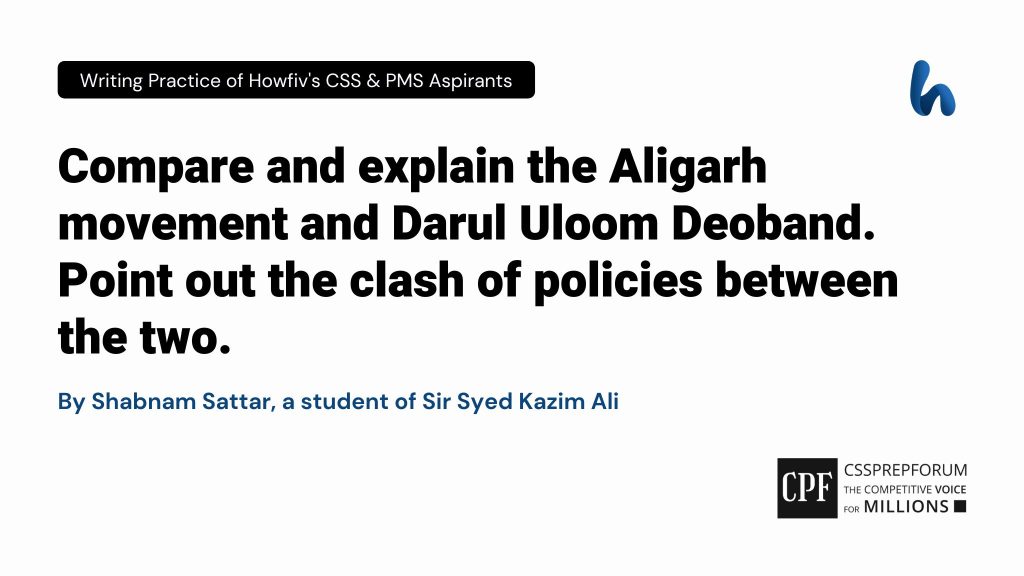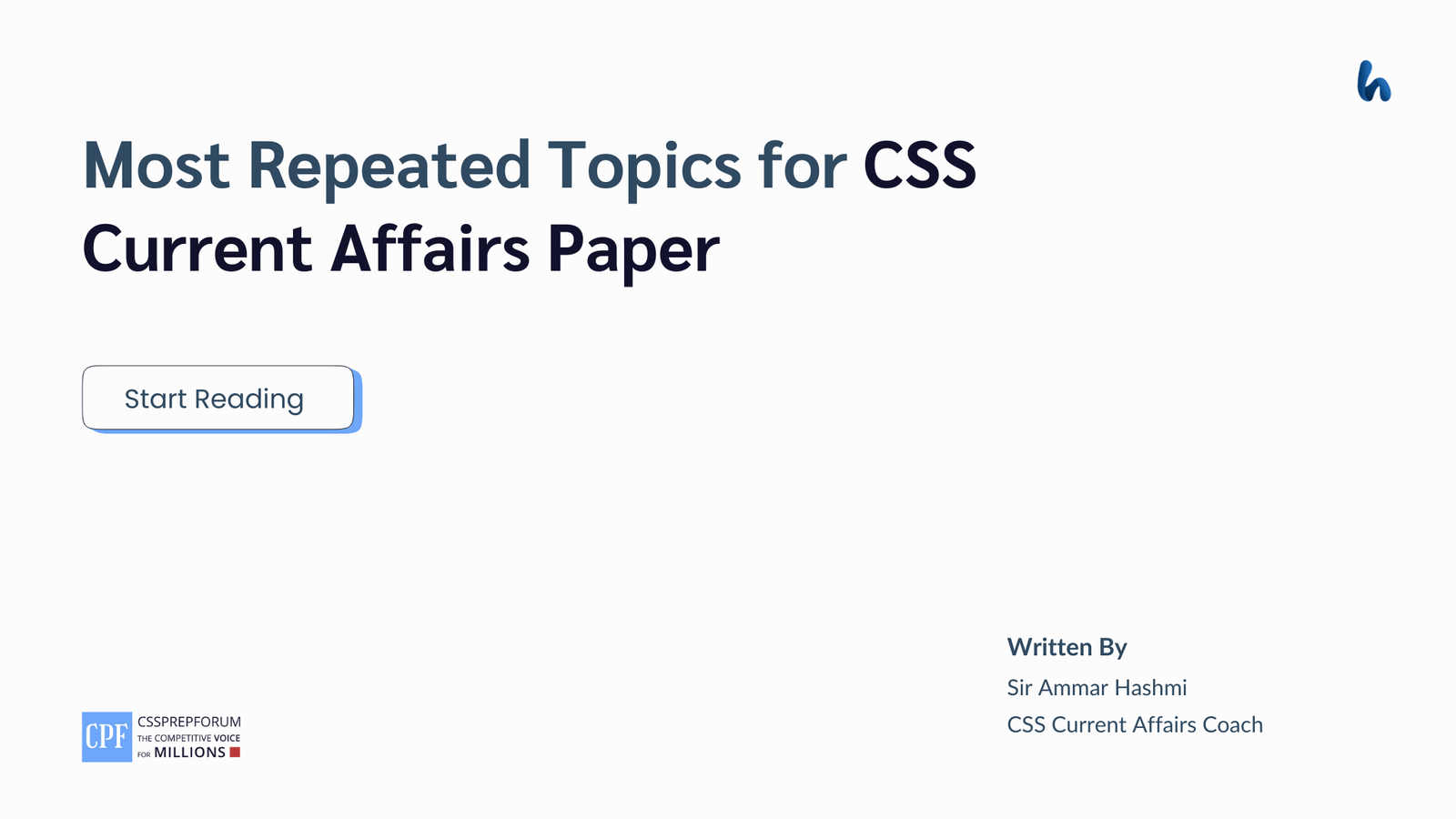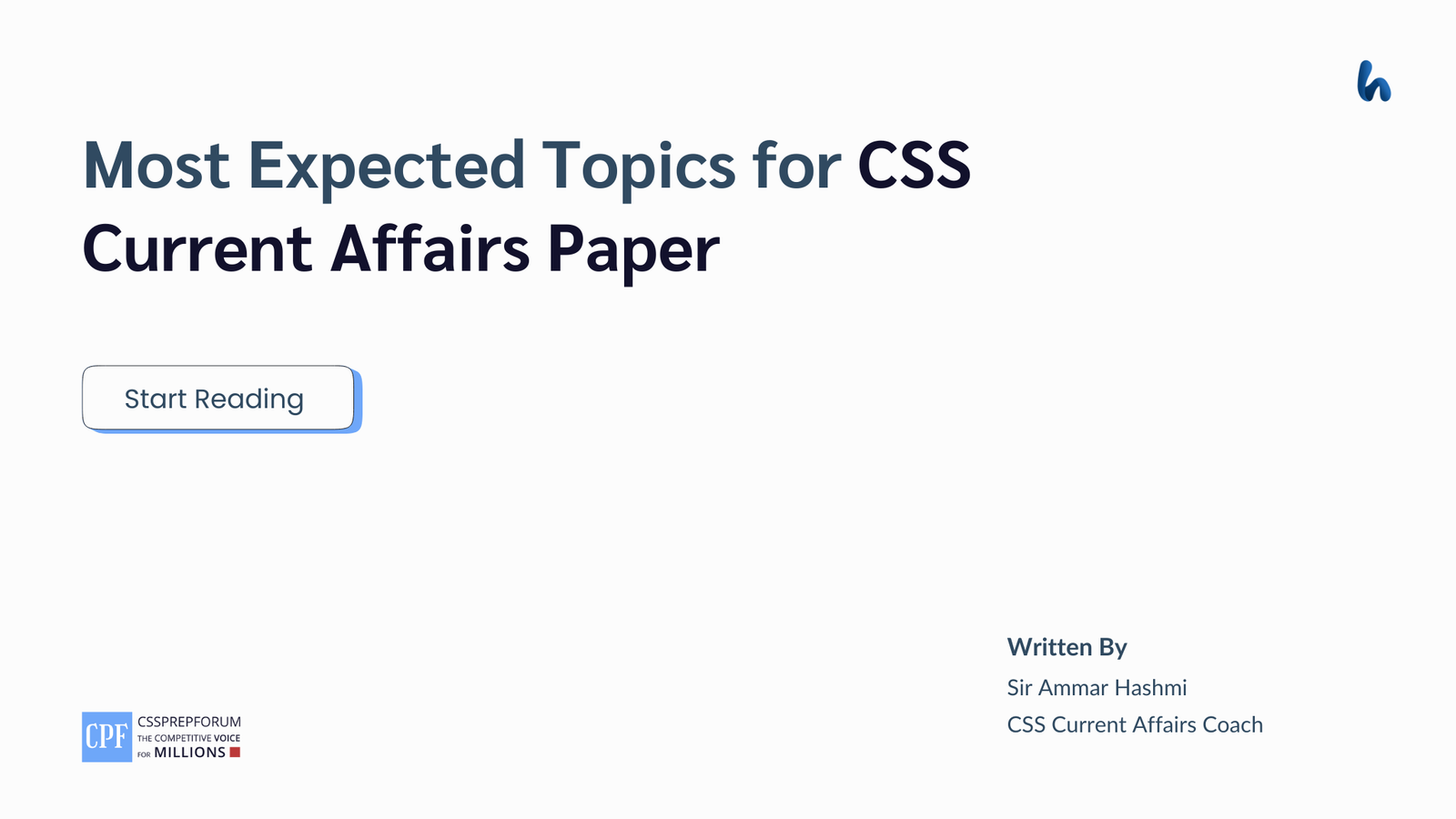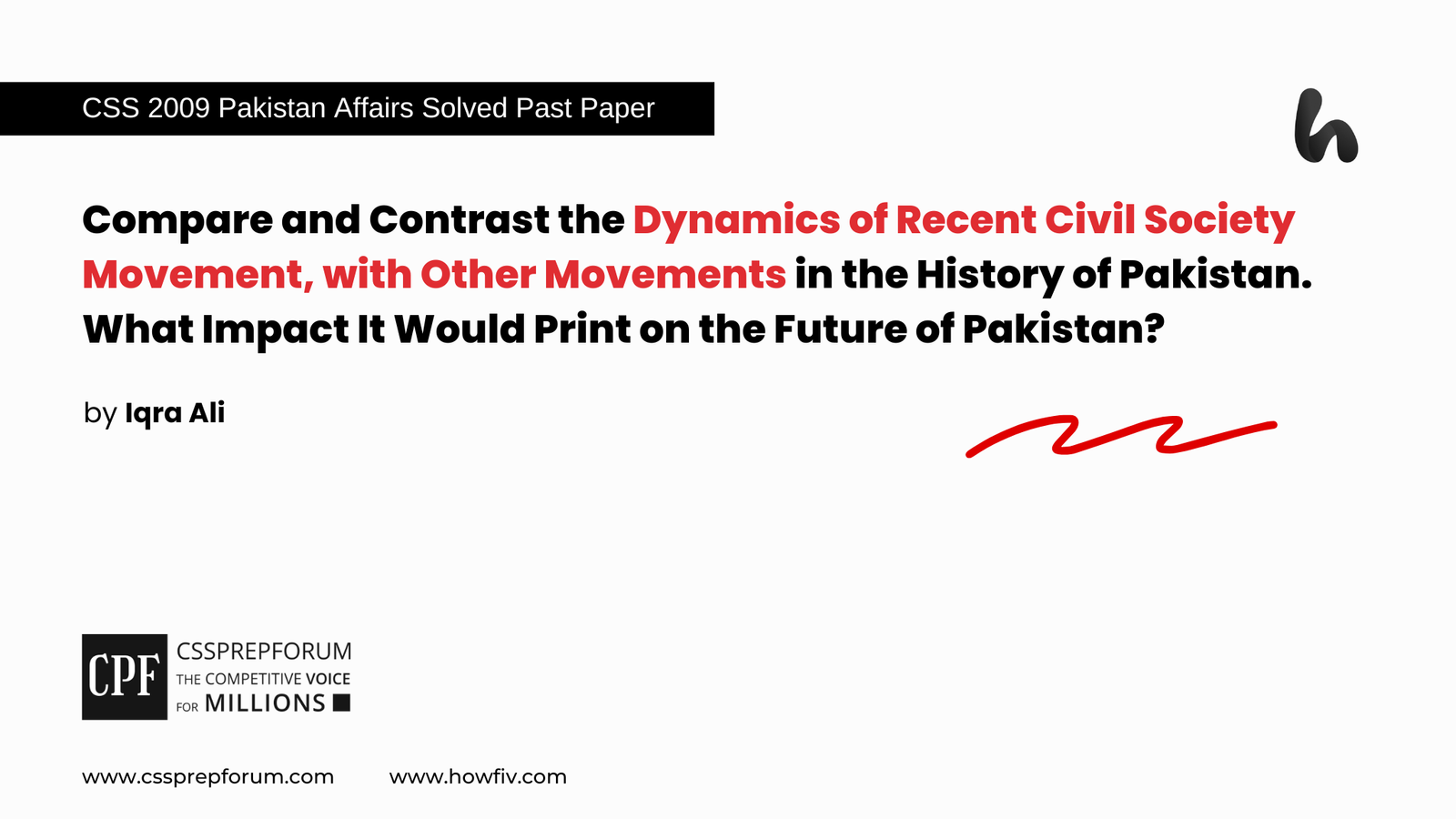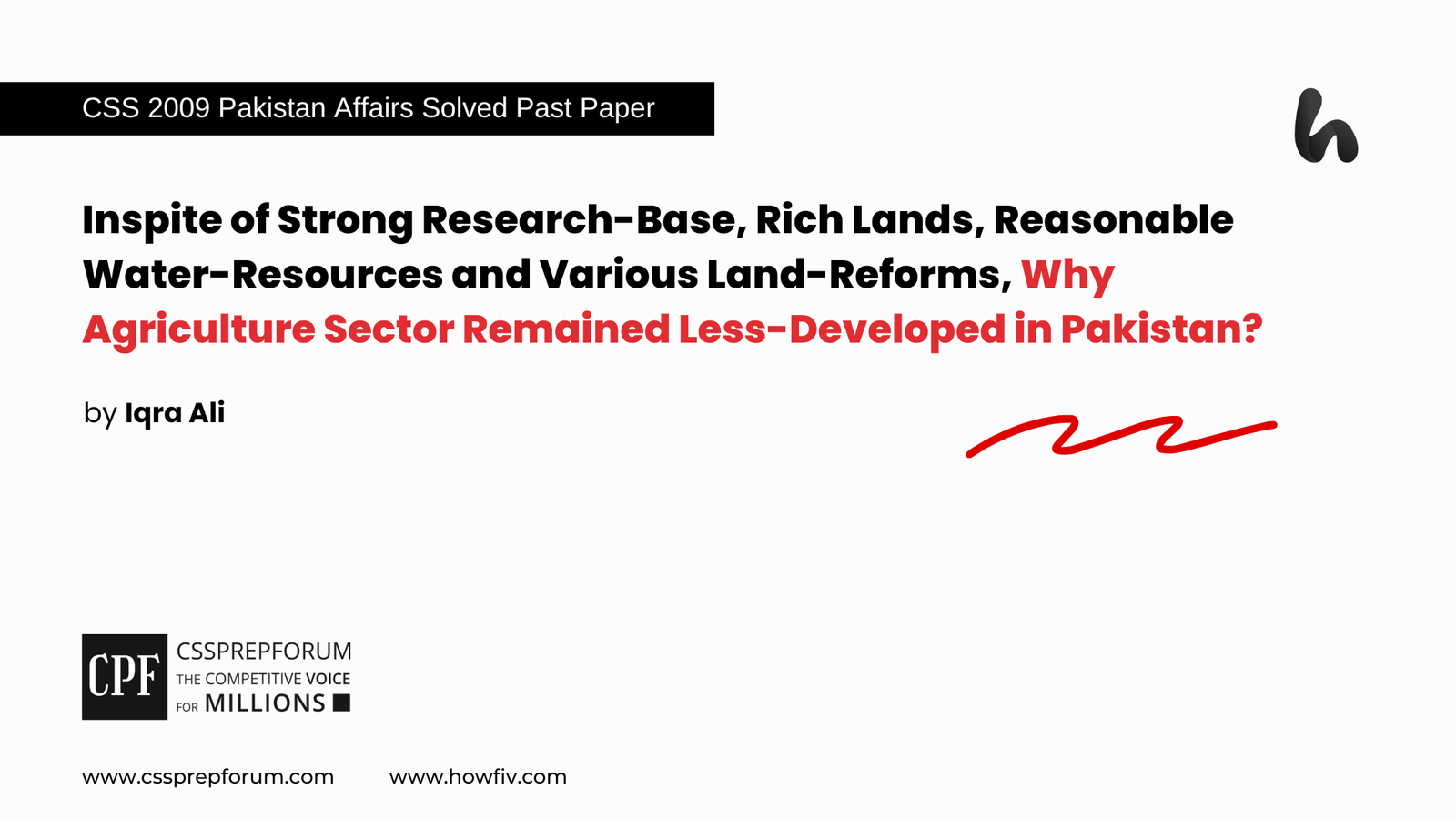The following article, “Compare and explain the Aligarh movement and Deoband. Point out the clash of policies between the two.” is written by Shabnam Sattar, a student of Sir Syed Kazim Ali. Moreover, the article is written on the same pattern, taught by Sir to his students, scoring the highest marks in compulsory subjects for years. Sir Kazim has uploaded his students’ solved past paper questions so other thousands of aspirants can understand how to crack a topic or question, how to write relevantly, what coherence is, and how to include and connect ideas, opinions, and suggestions to score the maximum.

Outline
1- Introduction
It is an unimpeachable fact that both the Aligarh movement and Darul Uloom Deoband strived for the educational enlightenment of Indian Muslims. However, there needs to be more clarity between their objectives, characteristics, instructional methods, political directives, disposition of agendas, and foreign policies. Despite the stark contrast, their roles in the national awakening and integrity cannot be subdued.
2- A brief history of the development of educational movements in India
3- Differences between the Aligarh movement and Darul Uloom Deoband
- ✓ Aims and Objectives
- Reformism vs Revivalism
- ✓ Ideological perspectives
- Liberalism vs Orthodoxy
- ✓ Instructional methodologies
- Western education vs Dars-e—Nizami
- ✓ Dispositions of agenda
- Materialism vs Spiritualism
- ✓ Political directives
- Political aloofness vs Active political involvement
- ✓ Foreign policies
- Pro-British vs Anti-British
4- Critical Analysis
5- Conclusion

Answer to the Question
Introduction
The Aligarh movement and Darul Uloom Deoband are equally considered to be the most influential educational movements in the history of the subcontinent. These campaigns pioneered the Islamic renaissance in India and emerged as the cornerstones of the Pakistan movement in the later stages. Although both Mohammedan Anglo-Oriental College (MAO) and Darul Uloom sought to empower Indian Muslims through educational enlightenment, there is a glaring disparity between their conceptual frameworks and administrative approaches. For instance, the Aligarh movement embraced a modernist stance on everything, ranging from the college curriculum to its pro-British policies. On the contrary, the Deoband institution remained largely orthodox and anti-British. Similarly, Aligarh had a reformist agenda, aiming at providing socio-economic opportunities to Muslims. Whereas the Darul Uloom was centred on the revivalism of Islamic spirit and principles. However, despite a clash of ideologies, both movements strived for the common goal of national awakening and integrity. And their contributions to the advancement and prosperity of Muslims cannot be subdued. The answer expounds on how the Aligarh and Deoband institutions vary in their objectives, nature, instructional methods, political directives, agendas, and foreign policies.
A Dire Need of the Hour: Development of Educational Institutions in India
The 1857 War of Independence resulted in the utter destruction and ruination of the Muslim community in India. They were not only deprived of their social, economic, and political rights but also were treated as third-class citizens because of their educational incompetence. Moreover, the Christian missionaries, with their ‘3G motto of God, Gold, and Glory,’ were adamant about undermining Muslim beliefs. At this point, Sir Syed Ahmed Khan took the onus on himself and worked unswervingly for the socio-economic uplift of the downtrodden Muslims. However, his efforts were highly condemned by some orthodox sects as lacking religious zeal. Therefore, to fill the void, Darul Uloom Deoband emerged as the reactionary movement against Aligarh and played a significant role in reforming Muslim society and preserving the Muslim culture from the influence of modernism and Westernization.
Differences between the Aligarh movement and Darul Uloom Deoband
Foundational Aims and Objectives
Sir Syed Ahmed Khan initiated the Aligarh movement as a reformist endeavour with the primary objective of changing the existent socio-political outlook of the subjugated Muslims in India. He focused on the rehabilitation of cordial relations between the Muslims and the British Raj, along with persuading Muslims to adopt Western education so that they could effectively compete with Hindus. On the other hand, Maulana Qasim Nanautavi’s Darul Uloom Deoband was a traditionalist movement centred on revivalism’of the long-lost Islamic spirit to take the Muslims back to their glorious past. To achieve this, the institution aimed at reducing religious degeneration and protecting the Islamic culture from being adulterated by Western ideals.
Ideological Perspectives
The Aligarh movement was liberal and modernist, with its entire thrust on Western-style education. Sir Syed, being a social reformer, highly criticized blind traditionalism in the name of religion. Instead, he advocated the reinterpretation of Muslim ideology and developed a framework of conciliation between modern science and Islam. Consequently, the MAO College became a hub of scientific and Oriental education in India. The Deoband institution, in contrast, staunchly opposed Sir Syed’s ideologies. It considered modern education to be the actual culprit behind the un-Islamic attitude in the Muslim community. Therefore, the Darul Uloom adopted an orthodox and conservative approach, with strict adherence to traditional Islamic learning and the promotion of Islamic values and practices.
Instructional Methods and Teaching Strategies.
The MAO college took a rational stance towards instructional methodologies corresponding to contemporary educational requirements. Along with English education and social sciences, extracurricular activities were also given due importance. For instance, Sir Syed established the ‘Siddons Union,’ a debating club modelled after the ‘Cambridge Union Society.’ It not only enhanced the students’ public speaking and critical thinking skills, but it also gave birth to Muslim intelligence. Conversely, the Darul Uloom prioritized religious-based theoretical education as the exclusive form of curriculum. Maulana Qasim introduced ‘Dars-e-Nizami’ as the official syllabus, which was much inspired by the teachings of ‘Madrasa-e-Rahimiya.’ It was centred on Quranic studies, Hadith, Tafseer, Ijtihad, Fiqh, Serf-o-Nehv, Shariah, Arabic, and Urdu literature.
Disposition of Agendas
Although the Aligarh movement’s true motive was the intellectual enlightenment of Muslims, it began to incline more and more towards a worldly agenda over time. Sir Syed’s pro-British outlook and efforts at reconciliation opened gateways to socio-economic opportunities for Muslims. They were assigned respectable posts in the government sector. They were also included in the trade and commerce policies, which resulted in the long-lasting economic prosperity of the Muslim community. On the contrary, the Tehreek-e-Deoband remained exclusively focused on its spiritual agenda’ and preservation of the Jihadi spirit against the British rulers. The revivalism of Islamic ethos undoubtedly saved the Muslims from falling into an abyss of religious degeneration. Still, it failed to provide any kind of economic assistance to Muslims on a greater scale.
Foreign Policies
The Aligarh movement is renowned for its pro-British attitude and cooperation policy. Sir Syed’s ‘Risala-e-Asbab-Bhagawat-e-Hind’ and ‘Loyal Mohammadens of India’ significantly fostered a spirit of amity between Muslims and the British Raj. As a result, the Aligarh movement became the only campaign that was equally patronized by every political faction in India. To illustrate, the then-Uttar Pradesh government granted the MAO a monthly stipend of ₹360. Similarly, Benares’ Raja Shambhu donated ₹60,000, and the Nizam of Hyderabad made a remarkable contribution of ₹5,00,000. On the other hand, Darul Uloom developed a staunch anti-British attitude from scratch, evident in its nationalist frameworks, such as the ‘Tehreek-e-Reshmi Rumal.’ Subsequently, the madrasa enjoyed no support from the British government; it only received a paltry sum as funding, that too from the Muslim lot.
Political Mandates
The Aligarh Institute adopted the policy of political aloofness and detachment from the Indian National Congress (INC). Sir Syed opined that Muslims temporarily lacked the capabilities for competitive political participation; therefore, they should build up their intellectual fortitude before engaging in politics. However, the Darul Uloom vehemently advocated active political involvement of Indian Muslims, believing politics to be the key factor in maintaining the ‘Jihadi spirit’ against Britishers. The institution supported the INC’s formation and issued a fatwa against Aligarh’s organizations like the ‘Indian Patriotic Association’ and the ‘MAO Defense Association’. In fact, the anti-Aligarh sentiments led some Deoband veterans, like Kifayatullah Dehlawi, Abdul Halim Siddiqui, and A.B. Firangi, to the point of forming ‘Jamiat Ulema-e-Hind,’ a nationalist political party, opposing the Pakistan cause.
Critical Analysis
Although both the Aligarh and Deoband movements have unequivocally been the mainspring of change in the oppressed Muslim populace of India, they remained in stark opposition to one another. The Darul Uloom, for instance, condemned Aligarh for its penchant for modern education and accused it of debauching traditional Islamic norms. In a letter to a friend of his and Sir Syed’s, Maulana Qasim Nanautavi stated, “No doubt, I greatly admire Syed Sahab’s courage and concern for the Muslims; however, upon hearing about his Fāsid beliefs, I have deep complaints and sorrow for him.”Aligarh, in turn, repudiated Deoband’s conservatism and aversion to change as an impediment to development and modernisation. In a nutshell, had it not been for these ideological rifts, the unanimity of these institutions would have been a catalyst for the collective progress of Indian Muslims.
Conclusion
To put it all together, the Aligarh movement and Darul Uloom Deoband are equitably significant in the history of Muslim rejuvenation in the subcontinent. The Aligarh movement was more liberal and modernist and aimed to advance social change in Muslim India in the vein of the West without weakening Islamic allegiance. The Deoband, a traditionalist and orthodox Islamic movement, sought to uphold and strengthen Islamic customs and principles, which were being threatened by the corrupted notions of Westernization. The institutions also shared differences in perceptions of administrative strategies, political mandates, foreign policies, etc. However, despite their diverging ideologies, both movements successfully achieved their goals of Muslim emancipation in British India. Even today, these institutions have carried on their educational legacies by promoting the development of Islamic thought and practice in the modern world.

CSS Solved Past Papers’ Essays
Looking for the last ten years of CSS and PMS Solved Essays and want to know how Sir Kazim’s students write and score the highest marks in the essays’ papers? Then, click on the CSS Solved Essays to start reading them.
CSS Solved Essays
CSS Solved General Science & Ability Past Papers
Want to read the last ten years’ General Science & Ability Solved Past Papers to learn how to attempt them and to score high? Let’s click on the link below to read them all freely. All past papers have been solved by Miss Iqra Ali & Dr Nishat Baloch, Pakistan’s top CSS GSA coach having the highest score of their students. General Science & Ability Solved Past Papers
Articles Might Interest You!
The following are some of the most important articles for CSS and PMS aspirants. Click on any to start reading.

